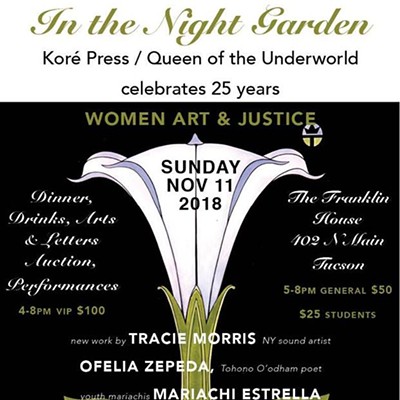If Emily Dickinson were alive today, she'd be celebrating her 181st birthday on Dec. 10.
She's not, of course. The poet died at 55 in 1886, but her Tucson fans are feting her birthday on Saturday anyway.
The party is the grand finale of The Big Read—the genre-jumping festival of poetry, music and dance that's been honoring Dickinson's life and work in Tucson all fall. Visual artists will open an exhibit of works inspired by her words; musicians will conjure Dickinson in music; and dancers will evoke Emily in dance. Everyone is invited to eat a piece of Dickinson birthday cake. (For a complete schedule, see the info box.)
The art opening kicks off the evening at 5 p.m. in a temporary pop-up gallery in the historic Firestone Building at Sixth Avenue and Sixth Street. Twenty-nine visual artists signed on to create works meditating on one of Dickinson's first lines. The Massachusetts poet wrote nearly 1,800 poems—only a few were published in her lifetime—and nearly every one begins powerfully.
Take the first line selected by local painter Catherine Eyde: "Hope" is the thing with feathers—.
Or this one: I heard, as if I had no Ear.
Artist Chika Matsuda picked the ear poem, and cast her own ear in white plaster. But she didn't do the expected thing. Instead of making a replica of the outer lobe, she went for the interior, as the tradition-busting Dickinson might have. Matsuda's sculpture is an image of her ear's internal passageways—where the ear hears.
"It's a wonderful piece, very minimal," says Heather Green, the artist who co-curated the show with photographer Valerie Galloway. (Lisa Bowden, the publisher of Kore Press and chief organizer of The Big Read, also had a hand in selecting the contributors.)
The first-line rule, decreed by Bowden, makes for "more-provocative" artwork, Green says. "It's wonderful for visual artists to respond to a fragment."
Because the exhibition honors a poet, Green and Galloway started out inviting only artists who work with texts—book-artist Beata Wehr, for example. For this project, Wehr made a book fragment based on the line We grow accustomed to the Dark—.
Two pages are stitched together. One side bears the image of a dark moon; the other is an inverted portrait of a woman.
Once word got out about the show, though, artists of all stripes wanted to enter, Green says, and she and Galloway abandoned their rule about text artists. However, Bowden—who got the National Endowment for the Arts grant that jump-started Tucson's Big Read—came up with another specification that would link the art to the written word: She dictated that each artwork had to be 8 inches high by 10 inches wide, the same size of the so-called fascicles—or booklets—into which Dickinson gathered her poems.
Within that framework, the art varies widely. Eyde's drawing, for instance, is worlds apart from Matsuda's minimal sculpture. Eyde specializes in deliberately naïve, sometimes fanciful painting, and here, she's imagined the cemetery in the rolling Massachusetts landscape where Dickinson is buried. A white bird is perched on Emily's tombstone. Papers inscribed with her poems are scattered among the flowers below. On a curling banner are the words, "thank you."
Eyde's bird, conjuring up the line "Hope" is the thing with feathers—, is one of many in the show, Green says. Dickinson was a serious gardener, and flowers, birds, snakes and other creatures make frequent appearances in her poetry. Janet Miller picked up on Dickinson's affection for nature, and her sometimes-overlooked humor, in Bee! I'm expecting you! In her reverse-glass painting, Miller imagines a romantic meeting between a fly and a bee. The shiny gold bee greets the fly with a bouquet of pink flowers.
Ellen McMahon submitted an austere black-and-white photo of a bone and a plastic bottle that mimics it. The piece appeared in her show at Pima Community College this fall, but here, she matches it with the Dickinson line Between the form of Life and Life.
By contrast, Barbara Rogers' oil on rag paper is brilliantly colored, a rich red covered with designs in gold, black and white. The work is inspired by There is an arid Pleasure—.
Kimi Eisele, a choreographer and dancer in the well-received NEW ARTiculations dance concert If my Verse is alive, created a paper cutout of a woman's bust bound tightly in a corset. (She knows whereof she speaks: The NEW ART dancers wore costumes based on 19th-century clothing.) Eisele's piece aptly suggests her Dickinson line, Bind me—I still can sing—.
For Green, the exhibition (named for the verse Delight—becomes pictorial—) does exactly what the whole of The Big Read was designed to do: bring readers to the poems.
"It's wonderful that the artists are reinterpreting Emily Dickinson's words, re-examining her works and what they mean now," she says. "The poems read fresh now.












